Posted on November 5, 2022
By Aja Kennedy, Summer 2022 Rappaport Public Policy Fellow, Massachusetts Housing Partnership (MHP)
This project is presented as the final product of a Summer Public Policy Fellowship funded by the Rappaport Institute for Greater Boston and in partnership with the Massachusetts Housing Partnership (MHP). I am grateful to Rappaport Institute and MHP for their support of this work. Views expressed here are those of the author and not necessarily those of MHP or Rappaport Institute.
Introduction
In January 2021, Massachusetts Governor Charlie Baker signed into law the new Multifamily Zoning Requirement for MBTA Communities. The new zoning law requires cities and towns served by MBTA public transit to create reasonably sized zoning districts where multi-family housing is allowed as-of-right, effectively reducing hurdles to multi-family unit construction within those rezoned areas. Through zoning for increased residential density, the law hopes to increase the supply of housing in these communities, especially in areas that lie close to public transit stops. The decision to enact this law serves as a major acknowledgement of the role of constrained housing supply in creating a Greater Boston housing market that does not offer affordable options for residents. The decision also recognizes the critical role of public transit in shaping functional cities that meet the needs of residents.
The law's intent to increase residential density in communities subject to the law has evoked a robust conversation surrounding the role of residential density in shaping local neighborhoods and communities. Proponents of the change cite potential to create vibrant, walkable neighborhoods with more housing availability, while opponents cite concerns of lowered property values, increased congestion, or budget constraints for municipalities who would need to serve the needs of an influx of new residents who move into newly constructed multifamily housing. This report's contribution to the debate does not cover all potential effects of zoning law changes, but instead focuses on the relationship between residential density and patterns of socioeconomic diversity to shine a light on the potential for zoning reforms to serve as a tool for creating equitable neighborhoods that are inclusive for diverse communities in Eastern Massachusetts.
Discriminatory housing policies such as redlining, or mortgage discrimination have historically contributed to the development of segregated neighborhoods across the United States. Academic literature points to evidence that, restrictive zoning, too, has historically been used as a tool to create and perpetuate segregated communities. Shertzer et al. (2022) explains how the origin of zoning laws in the 1910s was racially motivated. Ostensibly race neutral comprehensive zoning laws served as substitutes for explicitly racial zoning ordinances after the U.S. Supreme Court deemed the latter to be unconstitutional. Shertzer et al. (2016) uses a novel data set from the 1923 introduction of Chicago's first comprehensive zoning ordinance and finds quantitative evidence that Black neighborhoods are more likely to be zoned more densely and for industrial uses. Trounstine (2020) provides evidence that even in more contemporary decades, race continues to be correlated with decision-making on zoning laws. Evaluation of precinct level California election data shows Whiter voting precincts vote for more restrictive zoning laws. Rothwell and Massey (2013) and Rothwell and Massey (2009) find that U.S. metropolitan areas with more restrictive laws are more racially and socioeconomically segregated than metropolitan areas with more permissible zoning laws. The authors go a step further by using an instrumental variable estimation technique to argue that this relationship is causal.
Taken collectively, this literature tells us that restrictive zoning laws have origins in discriminatory intent, that racial patterns in local zoning decision-making continue to persist, and that restrictive zoning contributes to the segregation of communities. The importance of these findings is particularly salient in a state like Massachusetts, where local government has much control over zoning regulations below the state level. Given evidence that challenges the ethical implications of restrictive zoning and in the spirit of contributing to the broader conversation on residential density in Eastern Massachusetts, this brief takes a quantitative look at how residential density currently relates to the demographic makeup of communities in Eastern Massachusetts. This is done through use of Massachusetts Housing Partnership's “Residensity” dataset, which contains parcel level information about the number of residential units on each lot of land in the entire state of Massachusetts. By aggregating this data to the census block group level and matching with data from the U.S. Census 2020 American Communities Survey, we can put together information to help quantitatively analyze census block level relationships between residential density and the shares of non-White, renter, family, or vehicle commute reliant households within each census block group. Using scatterplots, histograms, and regressions, we find evidence that these variables are meaningfully correlated with residential density in Massachusetts and provide some thoughts about why we observe the quantitative relationships that we do.
We find that dense communities in Massachusetts are more racially diverse, have a larger share of renting households, and have a lower share of family households as a percentage of total households. Finally, in communities served by rapid transit (which are among the densest communities), there is markedly reduced reliance on vehicles for work commutes when compared to communities outside of the rapid transit network. We also find that more dense areas tend to have lower shares of family households as a percentage of total households. While results of this analysis in no way predict the effects of a zoning law change, thoughtful consideration of the observed relationships between density and these outcomes can inform how we think about potential effects of zoning reform on equity. By noting differences in the composition of households that make up denser versus less dense communities and pairing this information with previous research concerning the effect of zoning laws in segregation, we can acknowledge how our choices about zoning reflect our collective priorities in the creation of our communities and who is welcome in them.
Figure 1: MBTA Community Type
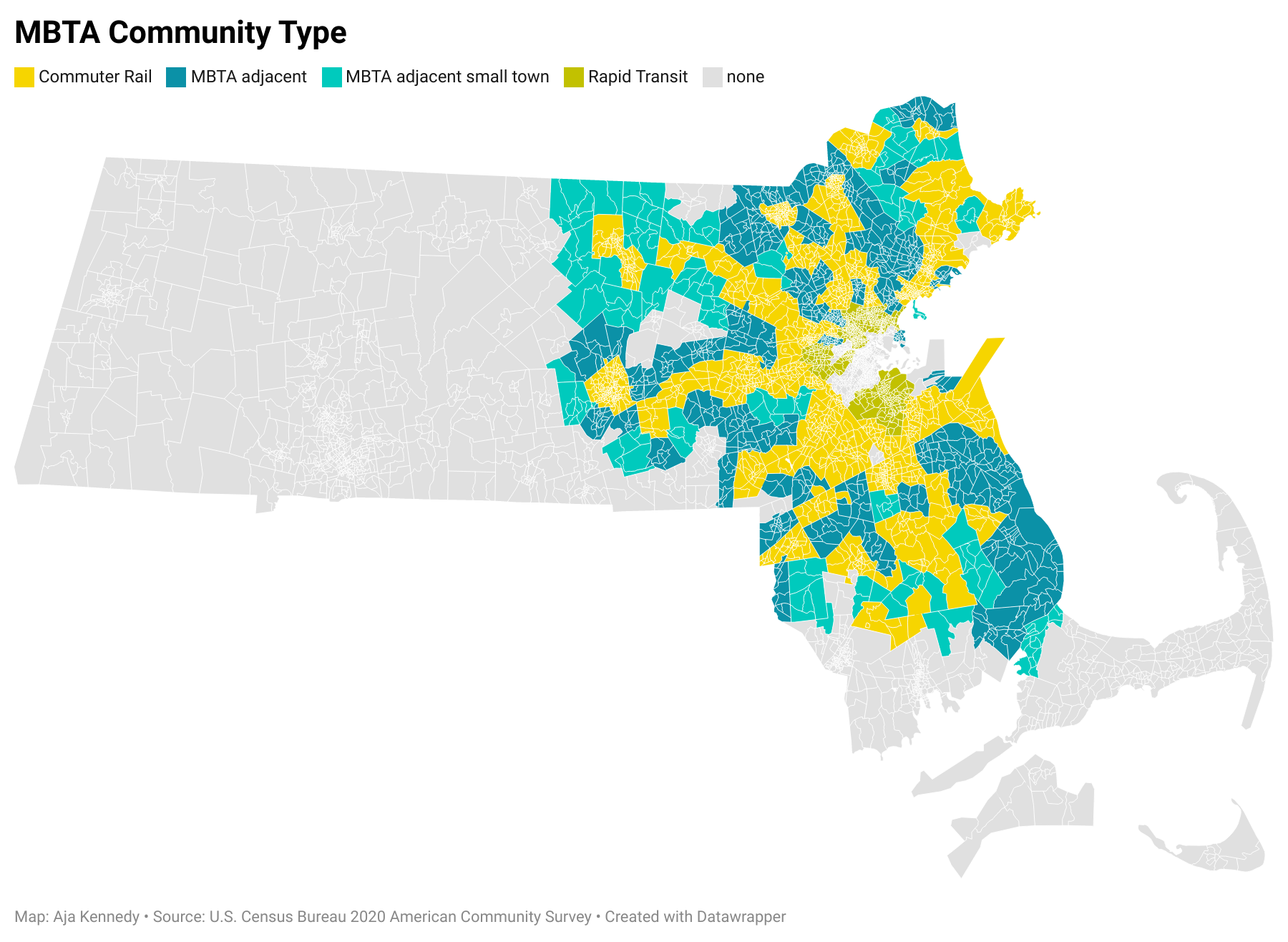
Figure 2: Residential Density by Census Block Groups
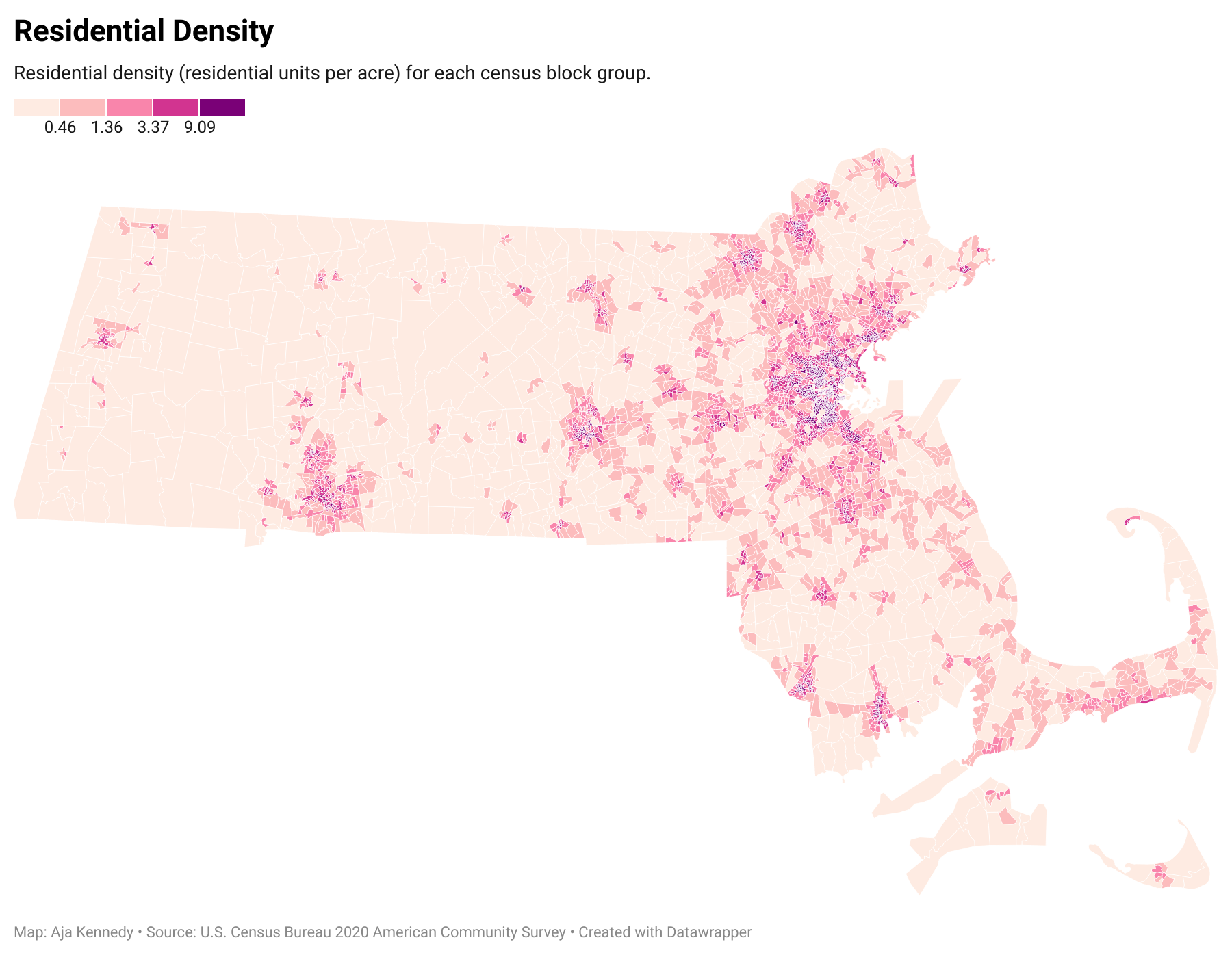
Summary of Findings
Racial Diversity and Renters
Dense communities are more diverse and have a higher proportion of renting households. Increasing residential density in communities in Eastern Massachusetts could be an opportunity to provide attractive housing options for renters and for households of different communities.
Figure 3: Percentage of Non-White Households by Census Block Group
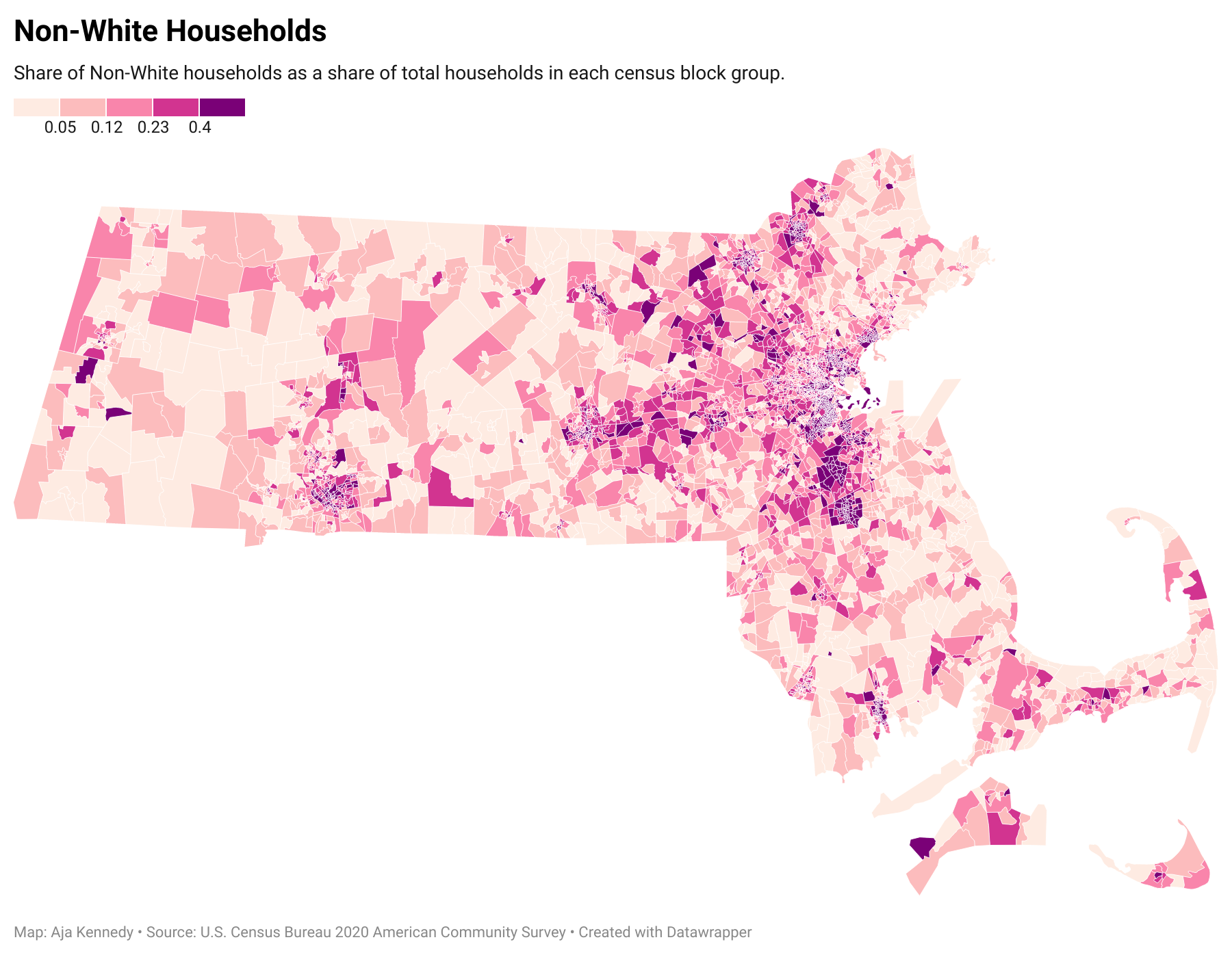
Figure 4: Percentage of Non-White Households by Census Block Group
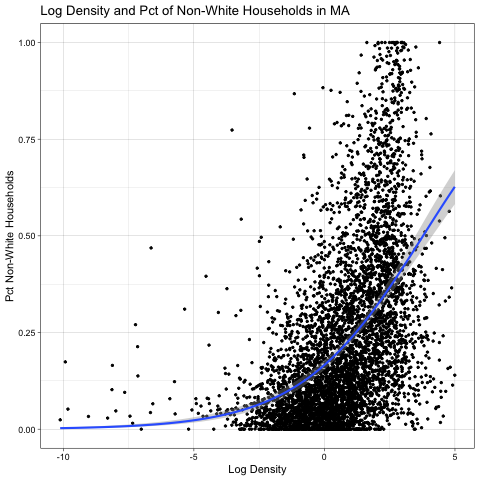
Figure 5: Percentage of Renter Households by Census Block Group
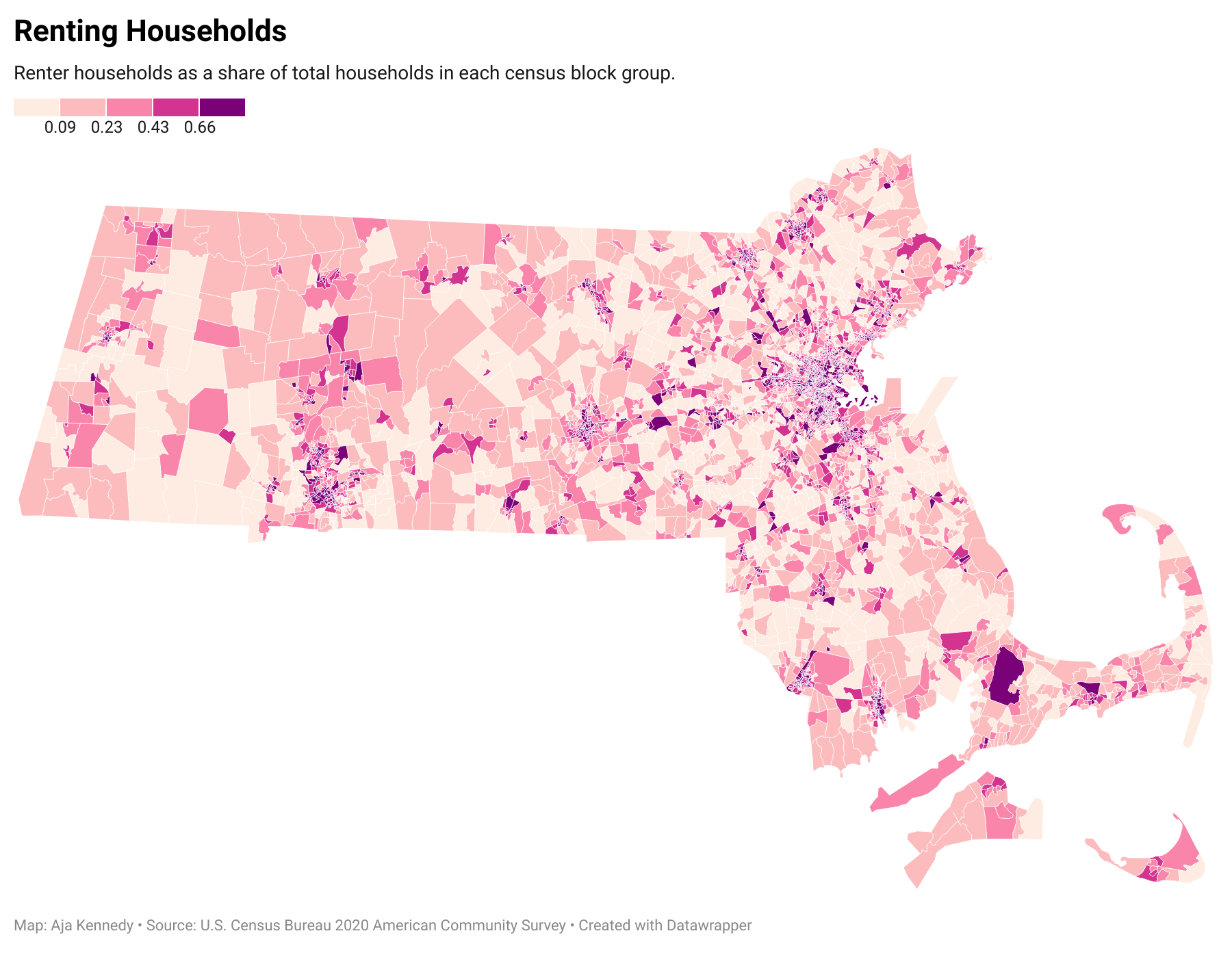
Figure 6: Percentage of Renter Households by Census Block Group
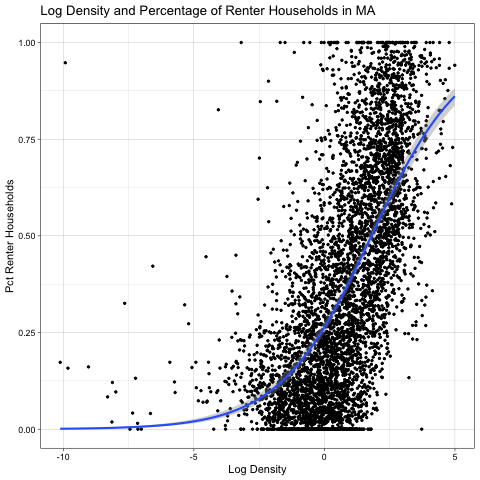
The maps in Figures 3 and 5 show the percentage of non-white and renter households, respectively, for each census block group across in the state of Massachusetts. If we compare these maps to the residential density map in Figure 2, we can see that census block groups with higher residential density tend to have a higher share of non-white households and a higher share of renting households. The scatter plots in Figures 4 and 6 tell a similar story. By plotting residential density (transformed to the log scale, plotted on the x axis) against percentage of non-white households (or renter households, plotted on the y axis) for each census block group, we find that non-white households tend to live in more densely populated areas. The results of a univariate logarithmic regression predict that an increase in residential density from median density to 75th percentile is associated with an increase in percentage of white households from the mean to third of a standard deviation above the mean, and that relationship is statistically significant (see: Appendix: Regression Tables - Univariate Regressions). This same increase is associated with an increase in percentage of renter households from the mean to half a standard deviation above the mean.
How do we interpret these patterns? The results do not mean that residential density causes communities to become more diverse, but observing that this relationship exists raise a question about the mechanisms that cause the relationship between the two. Further study of the results might help us think about the how a zoning reform that influences residential density might affect equity.
The causal effects of increasing residential density through relaxing restrictive zoning policies has not been quantitatively estimated, but findings of The Boston Foundation's 2019 Greater Boston Housing Report Card (GBHRC) suggest a law like the MBTA communities law could contribute to the creation of more inclusive communities. The report finds communities in Greater Boston that experienced greater housing production between 2000 and 2017 experienced greater reductions in racial segregation over the same time period, and finds this association held particularly strongly for communities that produced more multi-family housing (Modestino et al., 2019). Combined with aforementioned research on the effects of restrictive zoning on segregation, GBHRC's finding suggests if the MBTA communities law is successful in encouraging the construction of affordable multifamily housing, communities in Eastern Massachusetts could become more racially integrated.
Turning to the issue of renting households, we first acknowledge that priorities of renters and homeowners regarding zoning are not generally aligned. Homeowners may fear less restrictive zoning could negatively impact their property values and for many Americans, homes represent their most valuable asset (Taylor et al., 2011). Renters, on the other hand, may prioritize the ability to find an affordable place to live. In the United States, however, it is the homeowners who have typically dominated local politics (Einstein & Palmer, 2021). This is a salient point to acknowledge in a state like Massachusetts, where relatively weak county governments and geographically small municipal divisions mean that much of the politics below the state level is hyper local. To dominate local politics is to have oversized influence on local zoning ordinances. With an eye toward government representation of all different kinds of households, this suggests that the creation of equitable zoning ordinances must make a conscious effort to consider the welfare of renting households. Finally, given the wide racial homeownership gap in the state of Massachusetts (Schoenberg, 2021), we acknowledge that some communities of color are more likely to contain renting households, so there is some synergy to prioritizing considerations for both groups—non-White households and renting households.
Families
Communities lower in density have a higher proportion of family households. Ensuring a diversity of multifamily housing types and unit sizes in high density areas is critical to providing families with suitable housing options. While opening new multifamily rental opportunities in previously restrictive communities is important, we must also ensure that non-White households have access to suitable, affordable housing in neighborhoods with existing housing density as well.
Figure 7: Percentage of Family Households by Census Block Group
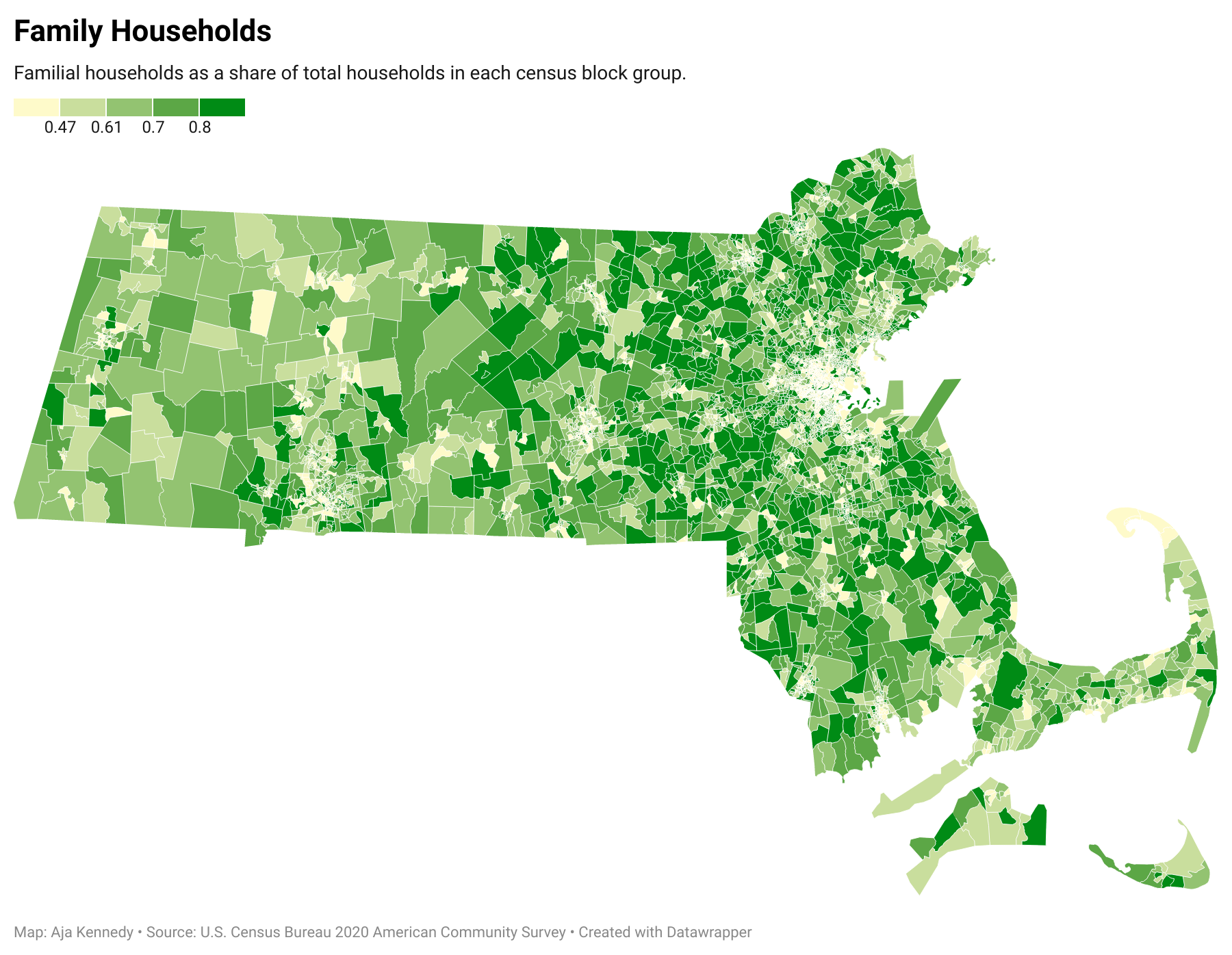
Figure 8: Percentage of Family Households by Census Block Group
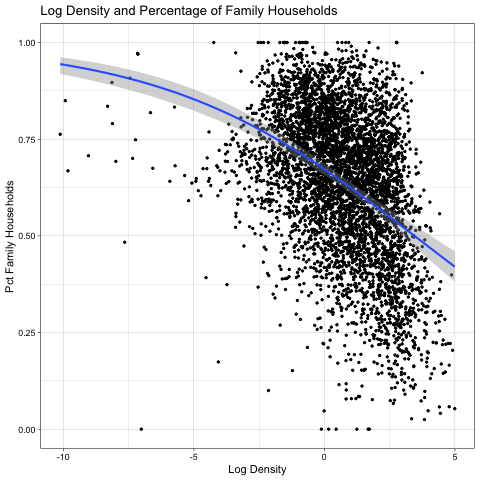
The map in Figure 7 shows the percentage of family households (as a share of total households) for each census block group across the state of Massachusetts. Figure 8 maps the natural log of residential density against percentage of family households for each census block group and fits a best fit curve to the graph. When we take both figures together, we can see that more densely populated census block groups tend to have a lower share of family households as a share of total households. Across census blocks in the state of Massachusetts, a move from median residential density to 75th percentile is associated with a fall in percentage of family households from the mean to a third of a standard deviation below the mean (see: Appendix: Regression Tables - Univariate Regressions).
Again, these results do not suggest that lower density causes high family households to become more common in the area. We can imagine different mechanisms that drive this relationship—maybe family households prefer larger living spaces, perhaps family households are better able to afford single-family style housing, or maybe family households have a more difficult time finding housing in dense neighborhoods. Regardless of causal mechanisms, we can apply an equity lens to this descriptive finding by combining it with a qualitative awareness of housing dynamics in the Greater Boston area.
As housing prices climb, affordability continues to be a concern for working class households, lower income communities, immigrant communities, and communities of color. Clearly the stock of housing is not meeting the needs of these communities, since increasing housing prices continue to push low income and minority households out of the urban core and into surrounding communities instead (Boston Indicators, 2019). This type of displacement can affect everything from the work commutes of displaced individuals who work near the urban core to the general welfare of children and families as they experience housing instability.
Communities that have less restrictive zoning policies (mainly communities in the inner-core or nearby, which in many cases are lower-income, communities of color and immigrant communities) are experiencing much of the new housing development driven by high housing demand in the relatively supply-constrained environment in the Greater Boston area. This contributes to long-time residents getting priced out. If there were more places in the MBTA region that didn't restrict multifamily housing development, perhaps less redevelopment pressure would fall to inner-core communities and remove some of the drivers of displacement.
With this dynamic in mind, we see the importance of the MBTA Community Zoning law's inclusion of a stipulation that districts zoned under this law must allow for family-suitable housing in order to give families the option to live in these areas. Displacement can be a burden to families, and diversifying housing in dense areas to accommodate more household structures ensures that families and children are able to find a safe, affordable, and stable housing options in a variety of locations and minimize the risk of displacement.
Finally, it is worth acknowledging a common argument of opponents of zoning reform, namely that increasing allowable residential density would be a burden for municipal budgets, since municipalities must absorb the cost of providing services to new residents of the community. Finding a way to balance municipal budgets under reformed zoning laws may be of particular importance when discussing housing for families (as opposed to housing for single young professionals), since families may include children, elderly family members, or other individuals who are not in the workforce and who may be more likely to make use of public services. MHP-commissioned research from UMass Dartmouth's Public Policy Center presents some evidence to refute the seriousness of this concern by evaluating six rental housing developments in the state and finding that these Massachusetts housing developments were a net fiscal benefit when both local and state tax costs and revenues are accounted for (Goodman et al., 2016). For the cases studied, only 31 percent of state revenue generated by the new developments would be needed to offset any negative fiscal impacts of housing developments on municipalities, meaning a strategic cost sharing scheme could easily create net positive benefits at both the local and state levels. In any case, we must remind ourselves that providing public services to residents is a central role of local government, and governments have a moral obligation to provide services to its residents regardless of race or income. Concerns about municipal budgeting should only go so far as to make sure a municipality can cover cashflows, and never to use lack of a budget as an excuse to promote exclusionary policy.
Vehicle Dependence
Areas served by rapid transit have much lower dependence on vehicles for work commutes. The focus on transit-oriented development in strategically planning for increasing density allows communities to take advantage of the potential for reduced reliance on vehicles.
Figure 9: Percentage of Vehicle Commuting Households by Census Block Group
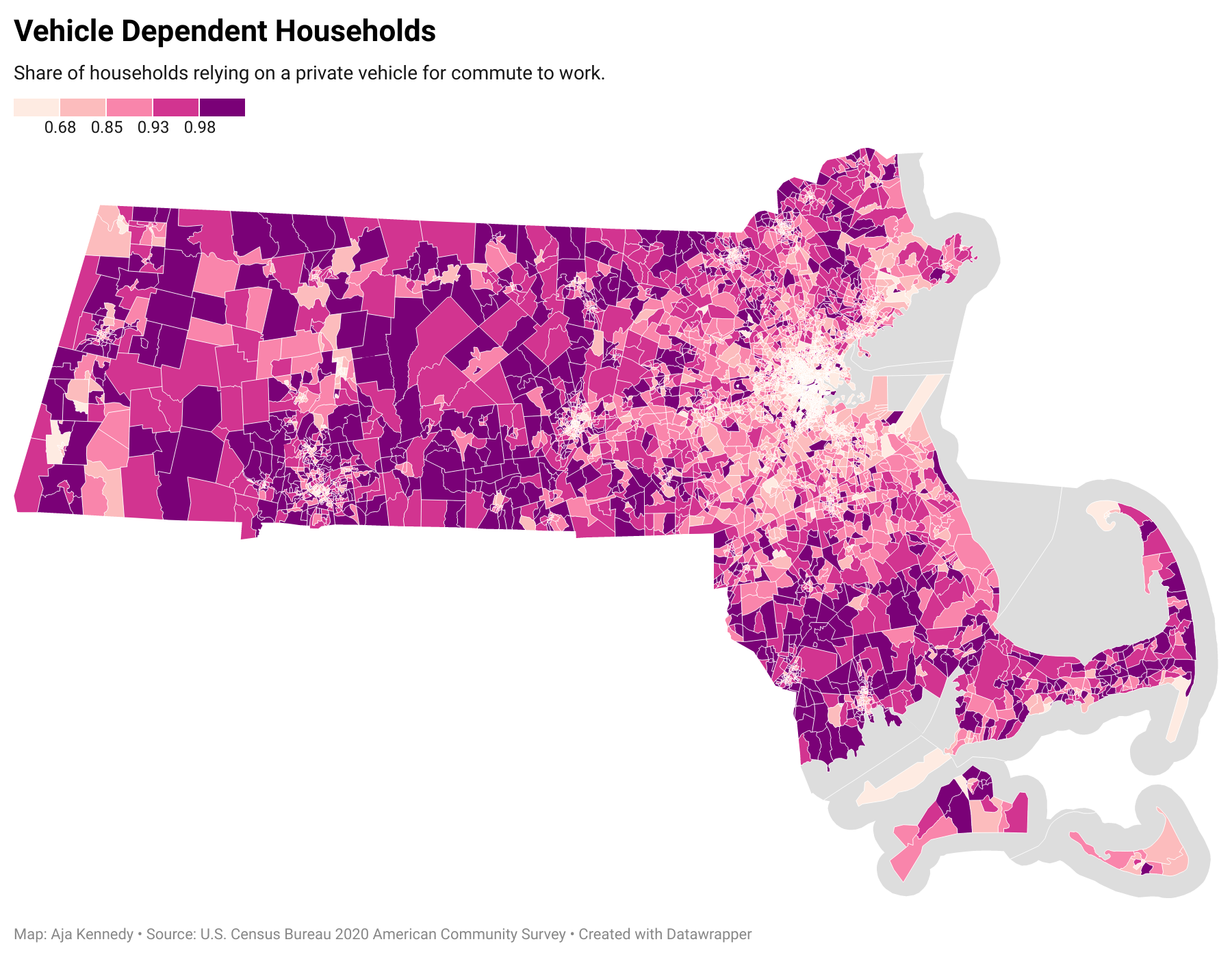
Figure 10: Percentage of Vehicle Commuting Households by Census Block Group
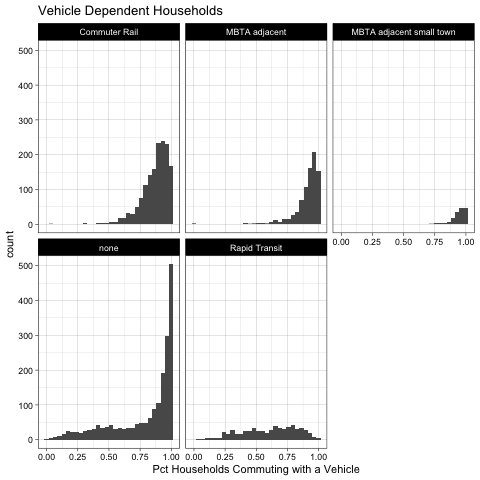
Figure 9 plots the percentage of households in each census block group who reported that they use a vehicle to commute to work. When we compare this map to the residential density map, we can see that more densely populated census block groups tend to have a lower share of households who are reliant on vehicles to commute to work. Figure 10 plots a histogram of the percentage of households in each census block group for each MBTA community category. By comparing these various distributions, we can see that the distribution for Rapid Transit communities is quite different from the others. Rapid Transit communities feature households who are generally a lot less reliant on vehicles to commute to work. Overall, about 59 percent of Rapid Transit households rely on vehicles for their commute, whereas 87 percent of Commuter Rail, 91 percent of MBTA Adjacent, and 94 percent of MBTA adjacent small-town households rely on vehicles to commute.
Concerns of increased congestion in communities that gain residential density highlight the importance of combining housing and land use policy with good transit policy for effectively implemented transit-oriented development. The aim is to realize potential benefits of transit-oriented development (e.g., reduced greenhouse gas emissions and reliance on vehicles) while reducing some of the potential drawbacks (e.g., increased congestion). To achieve these aims, we need to create communities that are more reliant on public transit (as opposed to private vehicles), which necessitates a capacity to increase ridership on public transit. This brief does not claim to comprehensively tackle the question of how to increase transit ridership, but notes that, since route frequency plays an important role in MBTA ridership, a focus on increased frequency of commuter rail service could help create opportunities for commuter rail communities to also become more reliant on transit rail services, rendering them better able to incorporate increased residential density with minimized impact on traffic congestion.
Combining These Factors
In a real-world setting, the factors we examined and other aspects will influence and be influenced by residential density through a variety of mechanisms. To begin to interpret the combined descriptive relationship between our variables of choice and residential density at the census block group level, we ran a simple linear regression of the natural log of residential density on percentage of non-white households, percentage of households with income below $75,000, percentage of renting households, the log of the percentage of vehicle-commuting households, the percentage of family households, and gross rent (see: Appendix: Regression Tables - Multivariate Regressions). We do this to find which variables most meaningfully predict residential density. All variables except gross rent had a statistically significant relationship with residential density in this model. If we divide the point estimate for each coefficient by its standard deviation, we find that the percentage of renters and the share of vehicle-commuting households have the strongest association with residential density in terms of economic significance. While all the factors mentioned in this analysis are critical for equity concerns in building complete neighborhoods, noticing which of these factors are most meaningfully associated with residential density helps give us a guess about which factors could be more heavily influenced by changes in residential density if the mechanism between residential density and these outcomes turns out to be causal.
Discussion
Restrictive zoning is an impediment to diversity in communities, and recent state-level legal actions limiting or eliminating single family zoning in Massachusetts, California, Oregon, and Maryland signal that perhaps state governments are beginning to meaningfully acknowledge that fact. These new state-level laws represent an opportunity to chip away at the roadblock of restrictive zoning and find out if less stringent zoning laws will allow for the creation of better housing opportunities for diverse communities.
In the Greater Boston area, constrained housing supply continues to drive burdensome housing prices; zoning to allow for higher residential density and increased local housing stock is in itself an arguably desirable strategy for addressing the housing crisis. However, if we think even more critically about the decision to relax zoning laws and look through an equity lens, we can see the Multifamily Zoning Requirement for MBTA Communities as an opportunity to redefine our neighborhoods and to signal that our priority as a community is to make sure all different groups are welcome. As households (especially immigrant, minority, and lower income households) continue to get displaced from their neighborhoods in the Greater Boston area, it is imperative that state and local governments use the tools at their disposal to create inclusive communities that feature suitable housing options for diverse households.
Appendix
References
(2019). Changing Faces of Greater Boston. Technical report, Boston Indicators, UMass Boston.
Einstein, K. L. and Palmer, M. (2021). Land of the Freeholder: How Property Rights Make Local Voting Rights. Journal of Historical Political Economy, 1(4):499–530.
Goodman, M. D., Koreiwa, E., and Wright, J. (2016). The costs and hidden benefits of new housing development in Massachusetts. Technical report, UMass Dartmouth Public Policy Center.
Modestino, A. S., Ziegler, C., Hopper, T., Clark, C., Munson, L., Melnik, M., Bernstein, C., and Raisz, A. (2019). The Greater Boston Housing Report Card 2019 Supply, Demand and the Challenge of Local Control.
Rothwell, J. and Massey, D. S. (2009). The Effect of Density Zoning on Racial Segregation in U.S. Urban Areas. Urban Affairs Review, 44(6):779–806.
Rothwell, J. T. and Massey, D. S. (2013). Density Zoning and Class Segregation in U.S. Metropolitan Areas. page 20.
Schoenberg, S. (2021). Baker official pitches housing plan to close racial homeownership gap. Shertzer, A., Twinam, T., and Walsh, R. P. (2016). Race, Ethnicity, and Discriminatory Zoning. American Economic Journal: Applied Economics, 8(3):217–246.
Shertzer, A., Twinam, T., and Walsh, R. P. (2022). Zoning and segregation in urban economic history. Regional Science and Urban Economics, 94:103652.
Taylor, P., Kochhar, R., Fry, R., and Velasco, G. (2011). Wealth Gaps Rise to Record Highs Between Whites, Blacks and Hispanics. page 39.
Trounstine, J. (2020). The Geography of Inequality: How Land Use Regulation Produces Segregation. American Political Science Review, 114(2):443–455
